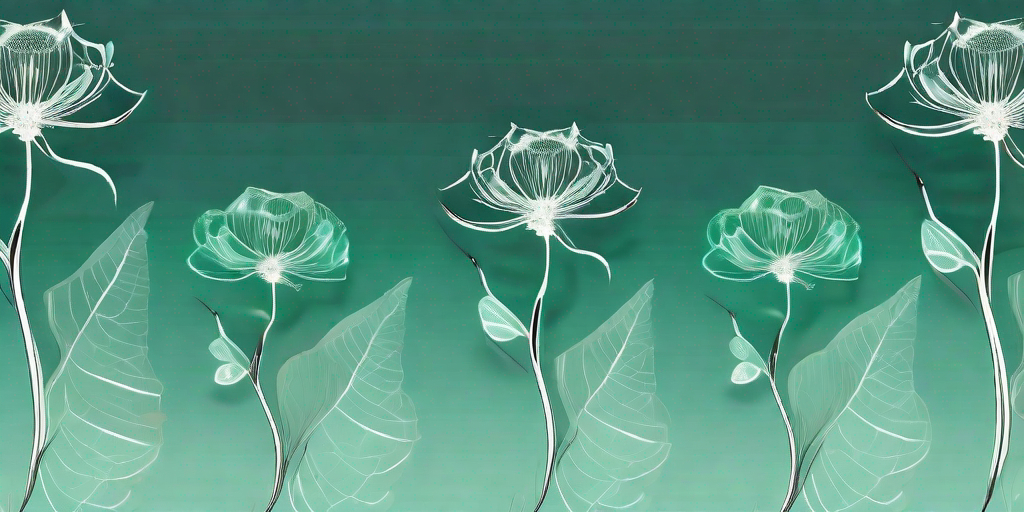
In the grand tapestry of nature, there are countless wonders to behold. From the towering majesty of the sequoia to the delicate intricacy of a spider's web, Mother Nature never ceases to amaze. But today, we're going to delve into a lesser-known marvel of the botanical world: the skeleton flower. This ethereal beauty, with its translucent petals, is as mysterious as it is captivating. So, buckle up, dear reader, and let's embark on a whimsical journey into the world of this intriguing creation.
The Skeleton Flower: An Introduction
Known scientifically as Diphylleia grayi, the skeleton flower is a perennial plant native to the woodlands of Japan and China. It's a bit of a wallflower, preferring the cool, damp understory of the forest to the limelight of sunnier climes. But don't let its modest demeanor fool you; this plant has a secret superpower that sets it apart from its botanical brethren.
When the rain falls, the skeleton flower undergoes a magical transformation. Its white petals become transparent, revealing a delicate network of veins that resemble a skeletal structure - hence the name. Once the rain stops and the petals dry, they regain their opaque white color. It's a bit like a botanical superhero, donning a disguise whenever the weather turns wet.
The Science Behind the Magic
The Transparency Trick
Now, you might be wondering how the skeleton flower manages this impressive disappearing act. Well, it's all down to the structure of the petals. When dry, the petals' surface has tiny microscopic bumps that scatter light, giving them their white color. But when they get wet, these bumps flatten out, allowing light to pass through and making the petals appear transparent.
It's a bit like wearing a white t-shirt in the rain. When dry, the fabric appears opaque, but once it gets wet, it clings to your skin and becomes see-through. Except, in the case of the skeleton flower, there's no embarrassing reveal of your favorite superhero undies.
Why the Disguise?
So, why does the skeleton flower go to all this trouble? Well, scientists believe it's a clever adaptation to its environment. In the shady understory of the forest, light is a precious commodity. By becoming transparent when wet, the petals allow more light to reach the leaves, aiding in photosynthesis.
It's a bit like taking off your sunglasses when you step inside from a bright day. You're letting more light in so you can see better. Except, in the case of the skeleton flower, it's more about making food than avoiding tripping over the cat.
How to Grow Your Own Skeleton Flower
Now that we've unveiled the mystery of the skeleton flower, you might be itching to grow your own. Well, you're in luck! Despite its exotic appearance, the skeleton flower is surprisingly easy to cultivate. Here's a step-by-step guide to help you get started.
-
Choose the right location: Skeleton flowers prefer shady, damp locations, much like their natural woodland habitat. A spot under a tree or on the north side of your house would be ideal.
-
Prepare the soil: These plants like well-drained, acidic soil. You can add peat moss or compost to improve drainage and acidity.
-
Plant the seeds: Sow the seeds about an inch deep and water thoroughly. Keep the soil moist but not waterlogged.
-
Wait and watch: With a bit of patience and care, you should see your skeleton flowers sprouting in a few weeks.
FAQs
Are skeleton flowers rare?
While not exactly common, skeleton flowers are not considered rare. They are, however, a bit tricky to find due to their preference for shady, secluded habitats.
Can I grow skeleton flowers in a pot?
Absolutely! Just make sure to choose a pot with good drainage and use a soil mix suitable for acid-loving plants.
Do skeleton flowers need a lot of care?
Not particularly. As long as they have the right conditions (shade, dampness, acidic soil), they're pretty low maintenance. Just keep an eye on the moisture levels, especially in dry weather.
Conclusion
And there you have it, folks! The skeleton flower - a botanical marvel that combines the beauty of a flower with the intrigue of a magic trick. Whether you're a seasoned gardener or a curious nature lover, this unique plant is sure to captivate your imagination.
So why not give it a go? Who knows, you might just find that growing your own skeleton flowers is the perfect way to add a touch of mystery and magic to your garden. After all, who doesn't love a plant that plays hide and seek with the rain?















